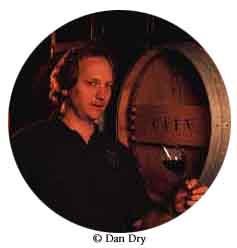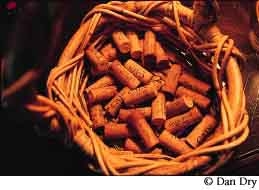The University of Chicago Magazine
October 1997


By Kimberly Sweet
Photography by Dan Dry
Summertime. Under the sun's hot gaze stretch acres of green vines, shifting before the cool hillside breezes. The vines lift their leaves and reveal heavy clusters of grapes, slowly deepening from delicate green to rich, dark purple. Lavender mountains-the Mayacamas and Vaca ranges embrace the Napa Valley. California's Highway 29 cuts through it.
During the glory days of summer, a parade of cars proceeds north along 29 from the city of Napa to Calistoga, cars filled with tourists come to partake of the valley's famed wine and hospitality. Most see only the romance of the vintner's life-style, a notion that Chris Howell, AB'75, cheerfully dispels. "You get dirty, you sweat a lot," he points out. "And you do a lot of me-nial work, because the primary job in winemaking is cleaning."
Howell is the general manager and winemaker at Cain Vineyard and Winery, just up the mountain from St. Helena, which is about 20 minutes south of Calistoga. To him, winemaking is "a practical art," one that combines nature and farming with culture and aesthetics, and one that he alternately dismisses as "at some level, not a very important thing at all" or raises to nearly a sacred plane. In his quest for "a compelling wine," Howell has a hand-often literally-in every aspect of the growing of the grapes and the making of the wine.
A warm, clear afternoon in July finds him looking
for Cain's new vineyard manager, Benjamin Falk, to discuss how best to nurture
some skinny young vines. Dressed in khakis and a "Les Outils Du Tonnelier"
(The Tools of the Cooper) T-shirt, a floppy-brimmed hat and sunglasses,
Howell, 45, revs his dust-flecked white Ford Explorer on a turbulent ride
through the terraced vineyard. Cain's 542 acres sit near the top of the
Mayacamas mountains, at heights from 1,400 to 2,100 feet. Only 84 of those
acres are planted with grapes, the five varieties traditionally grown in
Bordeaux: Cabernet Sauvignon, Merlot, Cabernet Franc, Malbec, and Petit
Verdot. Cain, which is considered a small operation, produces about 20,000
cases, or 240,000 bottles, of wine each year.
Howell stops the car to ask Falk's whereabouts of the crew,conferring with them in Spanish. The crew's been busy replanting vines, Howell tells his visitor, because of an American insect called phylloxera, a tiny louse that has attacked grapevine roots throughout the state. Cain's vines, like many others, are being replaced with rootstock-hardy, wild, American grapevine species-to which the European plants have been grafted.
The new vines, he admits, present their own problems. Driving past a patch of Cabernet Sauvignon, Howell spots one plant with leaves whose edges form a different pattern, and stops to check it out. As he'd suspected, the graft has failed and precious water is being wasted on a rootstock, so he takes a shovel from the back of the Explorer and chops away most of the flourishing rootstock to give the timid shoot of Cabernet Sauvignon at its base a chance to grow.
"Sorry," Howell apologizes matter-of-factly to the traumatized plant. "Hope you can heal. Maybe there'll be a new one of you in another year."
With the new plants, he's using a European technique called vertical-shoot positioning, in which the plants are placed close together and trained to grow using a trellis system, as opposed to the more laid-back "California sprawl." Although the vines certainly look much more orderly, that's not the point, explains Howell. "It's that the leaves aren't shading each other too much. Each leaf is getting sunlight, and the fruit for the most part is being exposed to sun."
Sun is vital for ripeness and flavor, which is why canopy management is an important task for the vineyard crew in the summer. Trimming away some of the leaves exposes the berries, or grapes, and removing some of the outer berries allows the inner ones to ripen, too.
"Too much fruit," proclaims Howell, "will make an insipid wine."
